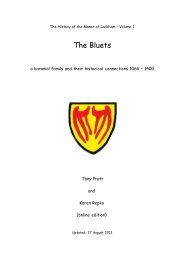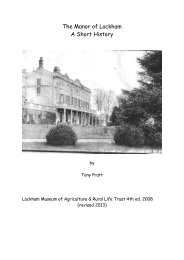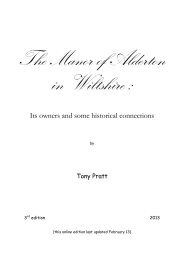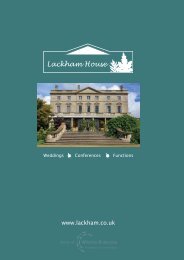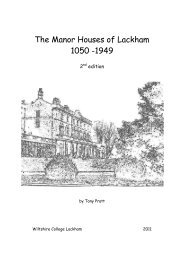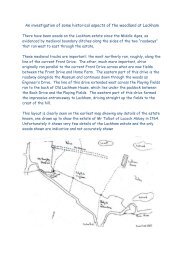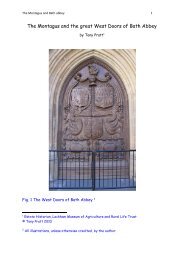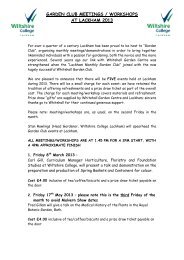History of Agricultural Education in Wiltshire - Lackham Countryside ...
History of Agricultural Education in Wiltshire - Lackham Countryside ...
History of Agricultural Education in Wiltshire - Lackham Countryside ...
You also want an ePaper? Increase the reach of your titles
YUMPU automatically turns print PDFs into web optimized ePapers that Google loves.
The orig<strong>in</strong>al cows (1959) had a high proportion <strong>of</strong> "Normead" blood<br />
from the Ben Cooper herd <strong>in</strong> them and further purchases <strong>of</strong> Normead<br />
bulls were made <strong>in</strong> 1961 and 1963, both <strong>of</strong> which were bought as calves<br />
for £50 each and reared at <strong>Lackham</strong>..<br />
Only one purchase <strong>of</strong> cattle was made <strong>in</strong>to this herd: 15 heifers from<br />
Norman Pike for £975 <strong>in</strong> 1967/68, so the herd has ben more or less selfconta<strong>in</strong>ed<br />
throughout. Performance <strong>in</strong> this herd has progressed satisfactorily<br />
over the years and now (1976) also stands at over 1100 gallons<br />
per cow.<br />
Both herds <strong>of</strong> cows have always been used for teach<strong>in</strong>g purposes and<br />
are milked by different students on a weekly basis throughout the<br />
College year while, at the same time, each is still looked after by one<br />
man, <strong>in</strong> 1959 two men looked after a total <strong>of</strong> 75 cows while today the<br />
two men are able to look after 155 cows.[i]<br />
THE BEEF HERD<br />
Pedigree Herefords formed the basis <strong>of</strong> the beef herd for many years. From<br />
very small numbers <strong>in</strong> the early days the number rose slowly to 10 - 12 cows and<br />
one bull <strong>in</strong> 1959 and were ma<strong>in</strong>ta<strong>in</strong>ed at around 15 cows until 1966/67. For all<br />
but the last year or two the cows s<strong>in</strong>gle suckled their own calves born <strong>in</strong> the<br />
spr<strong>in</strong>g.<br />
The orig<strong>in</strong>al cattle were from the Everlode Herd <strong>of</strong> Brig. General W<strong>in</strong>ser with<br />
subsequent bull purchases from the Wraxall Herd <strong>of</strong> Mr S M Evans and the Cheyney<br />
herd <strong>of</strong> Mr T L Parker. Sales comprised <strong>of</strong> steers sold fat or as stores while, over<br />
the years, a useful trade <strong>in</strong> the sale <strong>of</strong> yearl<strong>in</strong>g Hereford bulls for cross<strong>in</strong>g purposes<br />
was built up. Most heifer calves were reared and reta<strong>in</strong>ed.<br />
With <strong>in</strong>creas<strong>in</strong>g production costs it became <strong>in</strong>creas<strong>in</strong>gly more difficult to make<br />
these s<strong>in</strong>gle sucklers pay on the class <strong>of</strong> land which was used and so to try to<br />
improve the level <strong>of</strong> output each cow was given a foster calf to rear along with her<br />
own. This idea worked quite well but then the po<strong>in</strong>t was made that if more than one<br />
calf was to be reared there were better cows for the job than the pure Hereford.<br />
This led to the decision to change the breed <strong>of</strong> cow and <strong>in</strong> 1966/67, 20 Aberdeen<br />
Angus x Friesian heifer calves were purchased from Southern Counties <strong>Agricultural</strong><br />
Trad<strong>in</strong>g Society for £138 and reared to form the basis <strong>of</strong> a new suckler herd. A<br />
Hereford bull was used on these cross-bred cows and as they calved down the<br />
rema<strong>in</strong><strong>in</strong>g Herefords were sold. These Angus cross cows have proved very suitable<br />
for double suckl<strong>in</strong>g and still form the basis <strong>of</strong> the present herd <strong>of</strong> 20 cows.<br />
Hereford bulls were used on them until 1973 when a change was made to us<strong>in</strong>g the<br />
Charolais to produce a larger framed calf. Today, the 20 cows and their 40 calves<br />
paddock graze dur<strong>in</strong>g the summer on 12 acres <strong>of</strong> permanent pasture by the river,<br />
!



